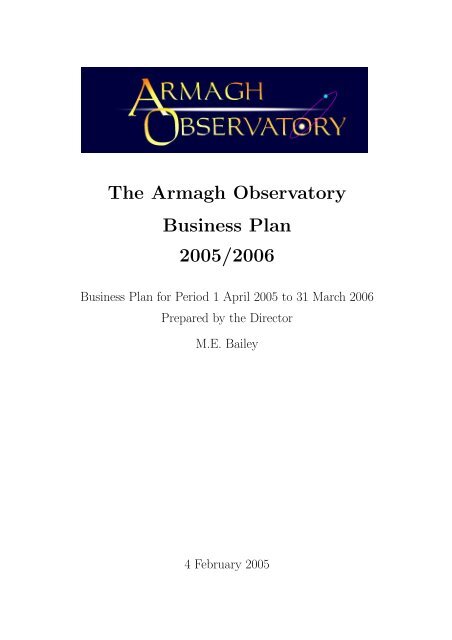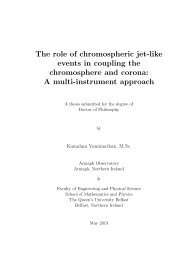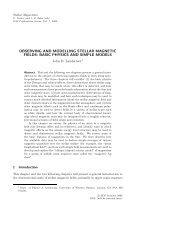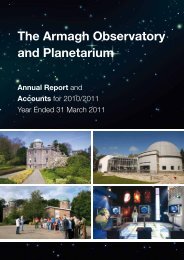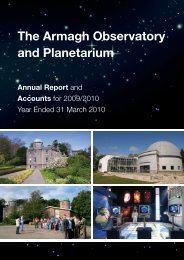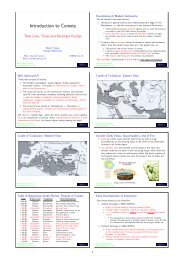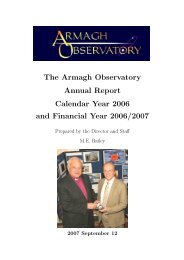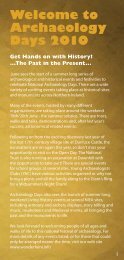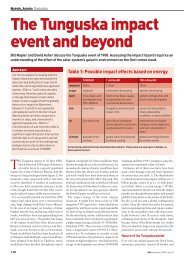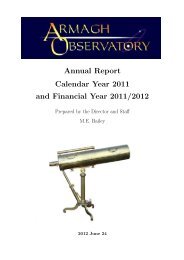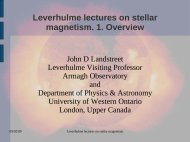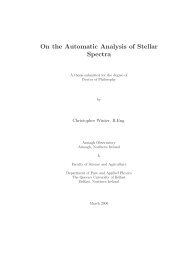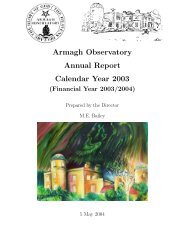The Armagh Observatory Business Plan 2005/2006
The Armagh Observatory Business Plan 2005/2006
The Armagh Observatory Business Plan 2005/2006
Create successful ePaper yourself
Turn your PDF publications into a flip-book with our unique Google optimized e-Paper software.
<strong>The</strong> <strong>Armagh</strong> <strong>Observatory</strong><br />
<strong>Business</strong> <strong>Plan</strong><br />
<strong>2005</strong>/<strong>2006</strong><br />
<strong>Business</strong> <strong>Plan</strong> for Period 1 April <strong>2005</strong> to 31 March <strong>2006</strong><br />
Prepared by the Director<br />
M.E. Bailey<br />
4 February <strong>2005</strong>
Executive Summary<br />
1. <strong>The</strong> <strong>Armagh</strong> <strong>Observatory</strong> has achieved considerable success during the past year (2004/<strong>2005</strong>). <strong>The</strong><br />
number of refereed journal publications, namely 41 plus one book, has been the highest since 1998;<br />
the number of identified media citations, namely 282, has remained at a high level, considerably<br />
above the target figure of 200; and the number of Distinct e-Visitors to the <strong>Observatory</strong> websites<br />
(http://star.arm.ac.uk/, http://climate.arm.ac.uk/ and http://arpc65.arm.ac.uk/∼spm/) has<br />
continued to grow. At the time of writing (January <strong>2005</strong>) total external grant receipts for Financial<br />
Year 2004/<strong>2005</strong> are currently estimated to be approximately £241,000. It is too early to know a<br />
definite figure, but the estimate is close to the target of £250,000 set in April 2004.<br />
2. <strong>The</strong> yearly trends of these various performance indicators are shown in Table 1 and Figure 1. Note<br />
that:<br />
• In recent years the <strong>Observatory</strong> has regularly obtained substantial levels of non-DCAL funding<br />
to support its research, currently averaging more than £250,000 per year, maintaining a high<br />
level of research activity throughout the period and an exceptionally high public profile.<br />
• During the past five years alone, astronomers at <strong>Armagh</strong> have averaged almost 35 publications<br />
per year in refereed scientific journals, and have appeared in or been quoted in newspapers<br />
and other media at least 250 times per year. In short, the <strong>Armagh</strong> <strong>Observatory</strong> is a flourishing<br />
astronomical research institute which continues to play an influential role in the professional<br />
advancement of astronomy and in public understanding of science and education.<br />
3. With sufficient resources to carry out its work, the <strong>Observatory</strong> remains in a strong position to maintain<br />
this activity and to play an influential role in both UK and international astronomy for years<br />
to come. However, the anticipated flat funding for Financial Year <strong>2005</strong>/<strong>2006</strong> will reduce core recurrent<br />
funding to the same level in cash terms as that for 2003/2004, i.e. from the present 2004/<strong>2005</strong><br />
value of £754,000 to £660,000 (<strong>2005</strong>/<strong>2006</strong>). This represents a 12.5% cut in cash terms that will<br />
inevitably put severe constraints on the <strong>Observatory</strong>’s ability to sustain its planned programmes of<br />
research, outreach and public understanding of science.<br />
4. <strong>The</strong> organization’s capacity to plan strategically is now being put at risk by the Department’s<br />
apparent inability to provide it with a secure core funding line. Moreover, the lack of additional<br />
research development funds places severe constraints on the organization’s ability to position itself<br />
strongly for the next Research Assessment Exercise. <strong>The</strong>re is a clear risk that a decade of improved<br />
performance in virtually every aspect of the <strong>Observatory</strong>’s activities (see Figure 1, p.3) could be<br />
undermined by systemic underfunding.<br />
5. If the <strong>Observatory</strong> is to avoid falling into this trap, it requires a stable level of core funding adequate<br />
for its needs and to support a reasonable number of research-active staff. In 2001 there were 8 such<br />
staff in post, but this has now fallen to 6 and there is a clear need to recruit at least 2 and preferably<br />
3 or 4 such staff, preferably young, ambitious and promising research scientists.<br />
6. Further background information about the <strong>Armagh</strong> <strong>Observatory</strong> is provided in Appendix A.<br />
It is noteworthy that the <strong>Observatory</strong> is the oldest scientific institution in Northern Ireland, the longest<br />
continuously operating astronomical research institute in the UK and Ireland. It is fully functioning, and<br />
remains a completely viable — and successful — research institute. In addition to its scientific research,<br />
which generates cultural capital, the <strong>Observatory</strong> also provides a very positive image of <strong>Armagh</strong> City and<br />
District — and of Northern Ireland — on the world stage, and makes major contributions both to DCAL<br />
departmental objectives and to the wider initiatives of the Northern Ireland Programme for Government.<br />
Objectives for Financial Year <strong>2005</strong>/<strong>2006</strong><br />
<strong>The</strong> anticipated parliamentary grant-in-aid for <strong>2005</strong>/<strong>2006</strong> is £660,000 (Resource Funding), the same in<br />
cash terms as in 2003/2004. This very significant real cut in the <strong>Observatory</strong>’s grant-in-aid puts many<br />
of the medium to long-term objectives of the <strong>Observatory</strong> at serious risk. In particular, because a high<br />
fraction of the <strong>Observatory</strong>’s overall running costs is related to core items such as salaries and fixed costs<br />
such as heat, light, power, insurance etc., the anticipated funding for <strong>2005</strong>/<strong>2006</strong> will put severe strain<br />
on the <strong>Observatory</strong>’s ability even to maintain its planned programmes of research, outreach and public<br />
understanding of science for <strong>2005</strong>. Such harsh treatment of a scientific institution which has demonstrated<br />
i
External Refereed Identified Distinct Total DCAL<br />
Calendar Year Grant Income Journal Media e-Visitors RAE Grade Grant Income<br />
(£000s) Publications Citations (DEVs) (£000s)<br />
2001 221 32 302 318,000 4 713.5<br />
2002 306 33 267 354,000 733.5<br />
2003 270 34 226 470,000 781.5<br />
2004 241 41 282 576,000 884.0<br />
<strong>2005</strong> Required Income: 773.4<br />
<strong>2005</strong> Targets: 200 35 200 400<br />
Table 1: <strong>The</strong> trend of various performance indicators (PIs) versus calendar year, including the total<br />
DCAL grant income received in cash terms in the corresponding financial year. (<strong>The</strong> figures include the<br />
announced capital and recurrent funding together with any in-year additional slippage funding received.)<br />
Also shown is the total budget required for <strong>2005</strong>/<strong>2006</strong>, namely £748,400 (Recurrent) and £25,000 (Capital).<br />
External grant income for 2004/<strong>2005</strong> represents a preliminary, unaudited estimate. Performance<br />
targets for calendar year <strong>2005</strong> (financial year <strong>2005</strong>/<strong>2006</strong>) are expressed in round figures.<br />
a decade of significantly improved performance flies in the face of Government policies that aim to increase<br />
spending on science and on programmes to encourage young people to consider careers in the traditional<br />
‘hard’ sciences.<br />
<strong>The</strong> allocated funds will be directed towards achieving the following principal objectives during<br />
<strong>2005</strong>/<strong>2006</strong>, namely to:<br />
• maintain existing high-quality research programmes;<br />
• obtain grants and additional external funding to support new research projects;<br />
• strengthen the <strong>Observatory</strong>’s research capability in solar system and stellar astrophysics in readiness<br />
for the next Research Assessment Exercise (RAE 2008; census date 31 October 2007);<br />
• enhance the <strong>Observatory</strong>’s access to and use of necessary research infrastructure, such as CosmoGrid,<br />
the Southern African Large Telescope (SALT), and the Northern Ireland Regional Area<br />
Network (NIRAN);<br />
• widen access to the heritage material in its possession; and<br />
• progress plans for a new Library, Archive and Historic Scientific Instruments Building.<br />
<strong>The</strong> corresponding targets for these objectives, which together span the <strong>Observatory</strong>’s principal areas of<br />
activity (research, education and public outreach, and heritage), are indicated in Table 1.<br />
<strong>The</strong> key task for the year is to obtain a stable level of core funding and to gain access to additional<br />
funds for the recruitment of additional research staff. This is to maintain current activity and to lay a<br />
strong foundation for the forthcoming Research Assessment Exercise (2002–2007). <strong>The</strong> required income<br />
(namely £748,400 Recurrent and £25,000 Capital) and projected expenditure for <strong>2005</strong>/<strong>2006</strong> is shown in<br />
Table 2.<br />
ii
Financial Year<br />
Last Up-Date 4 February <strong>2005</strong> <strong>2005</strong>/<strong>2006</strong> <strong>2005</strong>/<strong>2006</strong> 2004/<strong>2005</strong> 2003/2004 2002/2003<br />
Required Budget Projected Actual Actual<br />
(£k) (£k) (£k) (£k) (£k)<br />
Incoming Resources<br />
DCAL Capital Grant . . . . . . . . . . . . . . . . . . . . . . . . . . . . . . . . . 25.0 6.0 6.0 6.5 7.5<br />
Additional In-year Capital and Project Funding . . . . . . . . – – 145.9 103.1 –<br />
SALT . . . . . . . . . . . . . . . . . . . . . . . . . . . . . . . . . . . . . . . . . . . . . . . – – 40.0 40.0 40.0<br />
DCAL Buildings, Domes and Telescopes Project . . . . . . 22.2 22.2 25.0 30.0 31.0<br />
DCAL Recurrent Grant Announced . . . . . . . . . . . . . . . . . . . 748.4 660.0 660.0 660.0 616.0<br />
Additional In-year Recurrent Funds . . . . . . . . . . . . . . . . . . . – – 94.0 – –<br />
Total DCAL Grant . . . . . . . . . . . . . . . . . . . . . . . . . . . . . . . . . . 795.6 688.2 970.9 839.6 694.5<br />
Additional Funds from External Grants . . . . . . . . . . . . . . . 45.2 45.2 41.0 30.6 42.0<br />
Other Income . . . . . . . . . . . . . . . . . . . . . . . . . . . . . . . . . . . . . . . 9.7 9.7 9.5 14.0 9.1<br />
Total Incoming Resources . . . . . . . . . . . . . . . . . . . . . . . . . . . . 850.5 743.1 1021.4 884.2 745.6<br />
Less Resources Expended<br />
Capital Equipment . . . . . . . . . . . . . . . . . . . . . . . . . . . . . . . . . . 25.0 25.0 6.0 6.5 7.5<br />
Additional In-year Capital and Project Funding . . . . . . . . – – 145.9 103.1 –<br />
SALT . . . . . . . . . . . . . . . . . . . . . . . . . . . . . . . . . . . . . . . . . . . . . . . – – 40.0 40.0 40.0<br />
DCAL Buildings, Domes and Telescopes Project . . . . . . 22.2 22.2 25.0 30.0 31.0<br />
Salaries . . . . . . . . . . . . . . . . . . . . . . . . . . . . . . . . . . . . . . . . . . . . . 599.9 599.9 564.4 526.0 484.6<br />
Student Fees . . . . . . . . . . . . . . . . . . . . . . . . . . . . . . . . . . . . . . . . 8.0 8.0 8.1 7.6 6.4<br />
Library, Archives and Historic Scientific Instruments . . . 22.0 22.0 30.0 12.6 20.9<br />
JANET Access Costs . . . . . . . . . . . . . . . . . . . . . . . . . . . . . . . . 25.8 25.8 29.6 13.6 14.4<br />
Computer Consumables . . . . . . . . . . . . . . . . . . . . . . . . . . . . . . 13.0 13.0 13.0 12.1 11.1<br />
Travel and Subsistence . . . . . . . . . . . . . . . . . . . . . . . . . . . . . . 23.0 23.0 25.0 22.7 20.8<br />
Insurance . . . . . . . . . . . . . . . . . . . . . . . . . . . . . . . . . . . . . . . . . . . 14.0 14.0 13.6 16.5 15.3<br />
Heat, Light and Power . . . . . . . . . . . . . . . . . . . . . . . . . . . . . . 17.7 17.7 16.5 12.9 12.2<br />
Property Repairs and Grounds . . . . . . . . . . . . . . . . . . . . . . . 31.0 31.0 35.0 32.3 24.4<br />
Stationery, Post and Telephone . . . . . . . . . . . . . . . . . . . . . . 9.2 9.2 9.0 9.0 8.5<br />
Audits . . . . . . . . . . . . . . . . . . . . . . . . . . . . . . . . . . . . . . . . . . . . . . 5.7 5.7 5.5 3.9 4.1<br />
Professional Fees . . . . . . . . . . . . . . . . . . . . . . . . . . . . . . . . . . . . 3.0 3.0 6.5 5.1 −0.2<br />
Other Operating Costs . . . . . . . . . . . . . . . . . . . . . . . . . . . . . . 31.0 31.0 28.4 32.9 43.3<br />
Total Resources Expended . . . . . . . . . . . . . . . . . . . . . . . . . . . 850.5 850.5 1001.5 886.8 744.3<br />
Surplus = Income − Expenditure . . . . . . . . . . . . . . . . . . . . . 0.0 −107.4 19.9 −2.6 1.3<br />
Transfer to unrestricted reserves . . . . . . . . . . . . . . . . . . . . . 0.0 −107.4 19.9 −2.6 1.3<br />
Table 2: Summary of income and expenditure funded by the DCAL versus financial year (FY). Capital and<br />
other projects sometimes extend over more than one financial year, and in these cases the corresponding figures<br />
include amounts deferred to future years and/or released from prior years. <strong>The</strong> Table was last updated on 20<br />
January <strong>2005</strong>. All tabulated values have been rounded to the nearest £100.<br />
iii
1 Review of Financial Year 2004/<strong>2005</strong><br />
<strong>The</strong> principal objectives for 2004/<strong>2005</strong> were to:<br />
• maintain existing high-quality research programmes – done;<br />
• obtain grants and additional external funding to support new research projects – done;<br />
• strengthen the <strong>Observatory</strong>’s research capability in solar system and stellar astrophysics;<br />
• strengthen the <strong>Observatory</strong>’s access to research infrastructure such as CosmoGrid, the Southern<br />
African Large Telescope (SALT), and obtain high-bandwidth connections to the internet through<br />
the Northern Ireland Metropolitan Area Network (NIMAN) – done;<br />
• widen access to the heritage material in its possession – done; and<br />
• advance plans for a new Library, Archive and Historic Scientific Instruments Building – done.<br />
<strong>The</strong> key additional task for the year was to widen the <strong>Observatory</strong>’s access to research development funds<br />
and to lay a strong foundation for the forthcoming Research Assessment Exercise benchmark. This was<br />
to involve working with the DCAL not just to provide an adequate level of core funding for astronomical<br />
research, but also to obtain the further funds necessary for the recruitment of additional research staff<br />
and to maintain and improve the <strong>Observatory</strong>’s access to high-quality research infrastructure.<br />
In the event, it is unfortunate to record that no additional funding could be obtained for new staff<br />
positions during the reporting year, and the first six-months’ budget settlement for 2004/<strong>2005</strong> was the<br />
worst for many years. Nevertheless, there remains a strong argument both to maintain the present level<br />
of core funding in real terms and to provide the <strong>Observatory</strong> with additional research development funds.<br />
First, the <strong>Observatory</strong> has participated in the RAE for more than a decade, but has never benefited<br />
from access to the performance related additional funding enjoyed by comparable research groups in the<br />
university sector. Indeed, the <strong>Observatory</strong>’s position in this respect is doubly difficult owing to its small<br />
size, and this is not helped by further clipping of the institution’s wings. Unlike larger bodies there<br />
are very limited opportunities to transfer resources within the organization, and the inability to obtain<br />
additional research development funds puts the <strong>Armagh</strong> <strong>Observatory</strong> at a considerable disadvantage so<br />
far as expansion and strategic planning is concerned.<br />
Additional research staff would give the <strong>Observatory</strong> an opportunity to broaden the scope of its<br />
present research. <strong>The</strong>y would also provide the capacity to respond more flexibly to new research funding<br />
opportunities, thereby enhancing its ability to lever additional research income from the UK Research<br />
Councils and other grant-awarding bodies, so further increasing the <strong>Observatory</strong>’s output. Additional<br />
research development funds would thus enable the <strong>Observatory</strong> to operate more effectively in an extremely<br />
competitive third-level research sector.<br />
Moreover, the <strong>Observatory</strong> attracts substantial external funding per unit of DCAL grant-in-aid, currently<br />
averaging more than £250,000 per year, and has closely met or exceeded essentially all the performance<br />
targets set in the previous year, all of which are on ascending trajectories. It is extremely difficult<br />
to maintain this performance, and associated staff morale, in a situation where good performance is not<br />
rewarded.<br />
In addition to the above principal objectives, the <strong>Observatory</strong> has continued to play an influential<br />
community role in astronomy, for example through its high-level involvement in bodies such as the<br />
Astronomical Science Group of Ireland (ASGI) and in helping to organize the first joint meeting between<br />
the ASGI and the Institute of Physics in Ireland, held in <strong>Armagh</strong> from 1–4 April 2004, the largest<br />
astronomy meeting ever held in the City. <strong>The</strong> <strong>Observatory</strong> also plays a leading role in promoting the<br />
public awareness of astronomy and related sciences, especially through talks and public lectures, the<br />
release of media information sheets about its work, the appearance of staff or their work in various massmedia,<br />
and the provision of information through web-pages and links displayed on the <strong>Observatory</strong>’s<br />
principal web-site (http://star.arm.ac.uk/). <strong>The</strong> <strong>Observatory</strong>’s commitment to the Southern African<br />
Large Telescope project has continued with the support of the DCAL, and the largely HLF and DCALfunded<br />
project to restore the historic telescopes and telescope domes has been progressed satisfactorily.<br />
Performance<br />
As proxy indicators of performance in each of the <strong>Observatory</strong>’s principal areas of activity (research,<br />
education and public outreach, and heritage) records are maintained of (A) External Grant Income (per<br />
financial year); (B) the number of Refereed Journal Publications (per calendar year); (C) the number of<br />
1
Identified Media Citations (per calendar year); and (D) the number of Distinct e-Visitors (DeVs) to its<br />
web-sites (per calendar year). Although other data are recorded for internal management and statistical<br />
purposes (e.g. numbers of presentations, seminars and invited talks, grants and telescope time etc.),<br />
a detailed annual analysis of such indicators is less informative than a thorough periodic assessment<br />
of the <strong>Observatory</strong>’s research performance in the round, making allowance for the available resources<br />
and, for example, the <strong>Observatory</strong>’s relatively small size compared to many university departments and<br />
research institutes with which the <strong>Observatory</strong> is often compared. <strong>The</strong> <strong>Observatory</strong> has participated in<br />
the Research Assessment Exercise (RAE) since 1992, and during this period has maintained a Quality<br />
Research (QR) rating of Grade 4. In the 2001 RAE this grade corresponded to: “Quality that equates to<br />
attainable levels of national excellence in virtually all of the research activity submitted, showing some<br />
evidence of international excellence.”<br />
<strong>The</strong> trends of these principal performance indicators, provided in Table 1, are shown graphically in<br />
Figure 1. Note that all items refer to calendar year, with the exception of financial matters (e.g. external<br />
grant income for 2004 refers to the financial year 2004/<strong>2005</strong> and so on).<br />
So far as the particular indicators are concerned, the <strong>Observatory</strong>’s total non-DCAL income (approximately<br />
£250,000, a preliminary unaudited figure) slightly exceeds the value for external grant income<br />
alone (a preliminary, unaudited estimate of £241,000); the number of refereed journal publications is a<br />
lower limit to the total number of refereed papers, which is a subset of the <strong>Observatory</strong>’s entire research<br />
output; the number of identified media citations is a lower limit to the actual number of mentions of<br />
the <strong>Observatory</strong> or its staff in various mass-media; and the number of Distinct e-Visitors (DeVs) is the<br />
number of distinct hosts served by the <strong>Observatory</strong>’s web-site. This too is a lower limit, owing to caching<br />
by big servers and sharing or repeat visits from the same IP number. <strong>The</strong> number of DeVs can also vary<br />
significantly, depending on which computer programme is used to analyse the web-traffic. Here, we have<br />
chosen the average of two independent estimates, namely 381,000 and 771,000. In future years we plan<br />
to record just the lower figure.<br />
Total external grant income during 2004/<strong>2005</strong>, namely £241,000, was slightly below the target figure<br />
of £250,000 set in April 2004, and was again significantly boosted by contributions from the largely<br />
HLF-funded telescope domes and historic telescopes restoration project. As a group, the five Research<br />
Astronomers at <strong>Armagh</strong> have continued to bring into the <strong>Observatory</strong> more external funding in terms<br />
of non-DCAL grant income than their gross DCAL-funded salary costs, a remarkable achievement. This<br />
statistic alone demonstrates the potential for resonant growth associated with additional research staff.<br />
<strong>The</strong> target for external grant income for <strong>2005</strong>/<strong>2006</strong> has been set at £200,000, owing to the projected<br />
retirement of one Astronomer during <strong>2005</strong>. Considering the fierce competition for research grants, this<br />
still represents a challenging target.<br />
<strong>The</strong> number of refereed journal publications in 2004 has shown a substantial increase compared with<br />
the level of recent years, a highly commendable result given that the number of core research staff at<br />
the <strong>Observatory</strong> has shown no increase at all. Similarly, the number of identified media citations has<br />
remained at a high level, substantially above the target of 200 per year, and the number of DeVs continues<br />
to grow. Taken together, these results demonstrate a very satisfactory performance in research output,<br />
public profile and the external impact of the <strong>Armagh</strong> <strong>Observatory</strong>, despite the near-constant number of<br />
research-active staff.<br />
<strong>The</strong> chosen performance measures (Table 1 and Figure 1) show that the <strong>Observatory</strong> has maintained<br />
a very high level of research activity during the reporting period, has attracted substantial amounts of<br />
external income, and has maintained an exceptionally high public profile. For such a small research<br />
group, the frequency with which members of staff appear in or are quoted in newspapers and other media<br />
is probably second to none.<br />
New TSN Action <strong>Plan</strong><br />
New Targeting Social Need (TSN) is an overarching government policy that has the aim of tackling social<br />
need and social exclusion. It is intended as a long-term programme to mitigate the problems arising<br />
from social need, focusing particularly on issues of unemployment and ways to increase employability;<br />
on inequality in fields such as health, education and housing; and on factors that contribute to social<br />
exclusion which need a cross-departmental approach.<br />
New TSN is not a spending programme, but a theme which runs through spending programmes and<br />
which requires resources to be redirected within such programmes towards areas shown objectively to<br />
be in greatest need. Following a decision by the DCAL in 2003 to consolidate the TSN policies of the<br />
agencies, NDPBs and Statutory Bodies that it currently supports, the <strong>Armagh</strong> <strong>Observatory</strong> and <strong>Armagh</strong><br />
<strong>Plan</strong>etarium policies on New Targeting Social Need have been incorporated into an overarching DCAL<br />
2
Figure 1: Histograms showing various performance indicators for the <strong>Armagh</strong> <strong>Observatory</strong> during the<br />
past decade. <strong>The</strong> Figure shows respectively the variation of External Grant Income (£000s) per financial<br />
year, the number of Refereed Journal Publications, the number of Identified Media Citations, and the<br />
number of Distinct e-Visitors, all per calendar year. <strong>The</strong> financial year runs from 1 April to 31 March,<br />
so external grant income for 2004 corresponds to the period 1 April 2004 to 31 March <strong>2005</strong> and so on.<br />
Dotted lines indicate prior-year <strong>Business</strong> <strong>Plan</strong> targets.<br />
policy. For convenience we have continued to make the <strong>Armagh</strong> <strong>Observatory</strong>’s New TSN policy available<br />
on the internet and in hard copy on request. <strong>The</strong> New TSN Policy for <strong>2005</strong>, which was most recently<br />
reviewed in January <strong>2005</strong>, is available on the internet at http://star.arm.ac.uk/TSN.html and is appended<br />
to this <strong>Business</strong> <strong>Plan</strong> as Appendix B.<br />
2 Alignment of <strong>Armagh</strong> <strong>Observatory</strong> and DCAL Objectives<br />
2.1 Cultural Capital<br />
Cultural Capital is a key theme underlying the DCAL Strategic <strong>Plan</strong>. It depends on the fact that the<br />
largely creative Culture, Arts and Leisure sector produces products not just for immediate consumption<br />
and short-term benefits but for long-term utilization and as a contribution to the social and economic<br />
development (and external perception) of Northern Ireland as a whole.<br />
2.1.1 Research<br />
<strong>The</strong> <strong>Armagh</strong> <strong>Observatory</strong>’s principal function as an astronomical research institute is to produce and<br />
sustain Cultural Capital. This work is long-term, and makes a primary contribution to mankind’s accumulated<br />
knowledge about the world in which we live.<br />
<strong>The</strong> activity contributes, within Northern Ireland, to the generation of a more confident, scientifically<br />
3
literate, informed and prosperous community. It also helps to provide Northern Ireland with a rich<br />
scientific heritage and a unique cultural and educational resource.<br />
2.1.2 Education and Public Outreach<br />
An important secondary responsibility of the astronomers at <strong>Armagh</strong> is to care for and maintain the<br />
<strong>Observatory</strong> Grounds and Astropark, the Historic Library, Archives, and Buildings, and to preserve and<br />
display to the best advantage the historic telescopes and scientific instruments. <strong>The</strong>se activities provide a<br />
rich addition to the ecclesiastical and built heritage of the City of <strong>Armagh</strong>. <strong>The</strong>y also provide important<br />
synergies with the other specialist Libraries and Museums in the City (another DCAL responsibility), so<br />
helping <strong>Armagh</strong> to achieve a “critical mass” in this area.<br />
<strong>The</strong> <strong>Observatory</strong>’s active programme of education and public outreach attracts visitors to <strong>Armagh</strong>,<br />
primarily to the <strong>Armagh</strong> <strong>Observatory</strong> Grounds and Astropark, and to the Human Orrery and Phenology<br />
Garden. During 2004 approximately 20,000 visitors made use of the <strong>Observatory</strong> Grounds and Astropark.<br />
Thus, the <strong>Observatory</strong>’s achievements in astronomical research, as well as its efforts to promote greater<br />
public understanding of science, align closely with the DCAL’s aims to widen access to Northern Ireland’s<br />
cultural heritage, to create a confident, informed and vibrant community, and to protect, nurture and<br />
grow Northern Ireland’s cultural capital for the enjoyment of both present and future generations.<br />
In addition, the <strong>Armagh</strong> <strong>Observatory</strong> makes a unique contribution to projecting a positive image of<br />
<strong>Armagh</strong> City and District — and of Northern Ireland — on the world stage, and so contributes to greater<br />
awareness and economic prosperity of the whole region.<br />
2.1.3 Benefits of Astronomical Research<br />
1. Astronomy plays an increasingly important role in modern society. As an educational tool it attracts<br />
and maintains the interest of young people in science. It provides ‘clean’ examples of the use of<br />
science and technology, and makes a major contribution to knowledge of global environmental<br />
change.<br />
2. Modern astronomy is an involving, inspirational activity with a unique ability to spark the imagination<br />
and to attract young people towards science and engineering. It has an impact that can last<br />
a lifetime and inspire future generations.<br />
3. Scientists engaging in basic research contribute immeasurably to the intellectual vibrancy of society.<br />
<strong>The</strong>y also help to provide the conditions for a strong R&D base and those for society to participate<br />
in, and sometimes lead, scientific and technological projects of global significance.<br />
4. Research into astronomy leads naturally to increased public awareness of science and to the development<br />
of a more scientifically literate population. <strong>The</strong> fruits of astronomical research rekindle our<br />
unique ‘ability to wonder’: you can become like a seven or eight year old again.<br />
5. High-level scientific exchange and involvement in joint international projects, puts <strong>Armagh</strong> and<br />
Northern Ireland on the international stage, for example through the <strong>Armagh</strong> <strong>Observatory</strong>’s involvement<br />
in the Southern African Large Telescope project. Such collaboration also helps to encourage<br />
international co-operation and mutual understanding of cultural diversity.<br />
6. <strong>The</strong> UK and Ireland’s shared cultural heritage of astronomy leads to improved knowledge and understanding<br />
of both countries’ significant contributions to this international endeavour, contributing<br />
directly to greater mutual understanding and promoting ‘North-South’ and ‘East-West’ collaboration<br />
within the British Isles.<br />
2.2 Resonance with Government Policy<br />
<strong>The</strong> Government has set a 10-year goal to increase the ratio of UK R&D spending to national GDP<br />
from 1.9% to 2.5%, with science spending increasing at an average rate of 5.8% in real terms. Northern<br />
Ireland, and the DCAL in particular, can help to match this through their support for astronomy.<br />
It is also Government policy to improve science teaching and learning by promoting activities in<br />
education and public outreach that lead to greater participation in physical sciences and engineering in<br />
higher education. For example, the Office of Science and Technology’s “Science and Society” spending<br />
will increase from £4.25M per year in <strong>2005</strong>/<strong>2006</strong> to over £9.0M by <strong>2006</strong>/2007. <strong>The</strong> <strong>Armagh</strong> <strong>Observatory</strong>’s<br />
programme of school work experience and summer training (in excess of 100 contact days in 2004), as<br />
4
well as its other public outreach activities, helps significantly to widen access to science both amongst<br />
young people and the general public.<br />
3 Summary<br />
<strong>The</strong> anticipated parliamentary grant-in-aid for <strong>2005</strong>/<strong>2006</strong> is £660,000 (Resource Funding), the same in<br />
cash terms as in 2003/2004. This very significant real cut in the <strong>Observatory</strong>’s grant-in-aid puts many<br />
of the medium to long-term objectives of the <strong>Observatory</strong> at serious risk. In particular, because a high<br />
fraction of the <strong>Observatory</strong>’s overall running costs is related to core items such as salaries and fixed costs<br />
such as heat, light, power, insurance etc., the anticipated funding for <strong>2005</strong>/<strong>2006</strong> will put severe strain<br />
on the <strong>Observatory</strong>’s ability even to maintain its planned programmes of research, outreach and public<br />
understanding of science for <strong>2005</strong>. Such harsh treatment of a scientific institution which has demonstrated<br />
a decade of significantly improved performance flies in the face of Government policies that aim to increase<br />
spending on science and on programmes to encourage young people to consider careers in the traditional<br />
‘hard’ sciences.<br />
<strong>The</strong> allocated funds will be directed towards achieving the following principal objectives during<br />
<strong>2005</strong>/<strong>2006</strong>, namely to:<br />
• maintain existing high-quality research programmes;<br />
• obtain grants and additional external funding to support new research projects;<br />
• strengthen the <strong>Observatory</strong>’s research capability in solar system and stellar astrophysics in readiness<br />
for the next Research Assessment Exercise (RAE 2008; census date 31 October 2007);<br />
• enhance the <strong>Observatory</strong>’s access to and use of necessary research infrastructure, such as CosmoGrid,<br />
the Southern African Large Telescope (SALT), and the Northern Ireland Regional Area<br />
Network (NIRAN);<br />
• widen access to the heritage material in its possession; and<br />
• progress plans for a new Library, Archive and Historic Scientific Instruments Building.<br />
<strong>The</strong> corresponding targets for these objectives, which together span the <strong>Observatory</strong>’s principal areas of<br />
activity (research, education and public outreach, and heritage), are indicated in Table 1.<br />
<strong>The</strong> key task for the year is to obtain a stable level of core funding and to gain access to additional<br />
funds for the recruitment of additional research staff. This is to maintain current activity and to lay a<br />
strong foundation for the forthcoming Research Assessment Exercise (2002–2007). <strong>The</strong> required income<br />
(namely £748,400 Recurrent and £25,000 Capital) and projected expenditure for <strong>2005</strong>/<strong>2006</strong> is shown in<br />
Table 2.<br />
5
A<br />
Institutional Background<br />
Vision<br />
<strong>The</strong> Vision of the <strong>Armagh</strong> <strong>Observatory</strong> is:<br />
“To maintain and build on its position as a thriving astronomical research institute, and to<br />
continue to expand our understanding of the Universe and of humanity’s place in it.”<br />
<strong>The</strong> Mission is:<br />
“To advance the knowledge and understanding of astronomy and related sciences through the<br />
execution, promotion and dissemination of astronomical research nationally and internationally<br />
in order to enrich the intellectual, economic, social and cultural life of the community.”<br />
<strong>The</strong> <strong>Armagh</strong> <strong>Observatory</strong> (see http://star.arm.ac.uk/) is the oldest scientific institution in Northern<br />
Ireland, founded by Archbishop Richard Robinson in 1790 as part of his dream to see the creation of a<br />
university in the City of <strong>Armagh</strong>. It stands close to the centre of the City of <strong>Armagh</strong> together with the<br />
<strong>Armagh</strong> <strong>Plan</strong>etarium in approximately 14 acres of attractive, landscaped grounds known as the <strong>Armagh</strong><br />
Astropark. <strong>The</strong> Astropark, which is managed by the <strong>Observatory</strong>, includes two sundials and scale models<br />
of the solar system and the Universe, and features a number of outdoor exhibits and interpretation<br />
panels (see http://star.arm.ac.uk/astropark/). A new public outreach facility, the Human Orrery (see<br />
http://star.arm.ac.uk/orrery/), has recently been opened in the <strong>Observatory</strong> grounds to the south-east<br />
of the main building of the modern <strong>Observatory</strong>.<br />
<strong>The</strong> principal function of the <strong>Armagh</strong> <strong>Observatory</strong>, which is a third-level institution funded by the<br />
Northern Ireland Department of Culture, Arts and Leisure (DCAL), is to undertake original research of<br />
a world-class academic standard that broadens and expands our understanding of astronomy and related<br />
sciences. Current key programmes focus on Stellar Astrophysics, the Sun, Solar System astronomy,<br />
and Solar System – Earth relationships including the Sun’s influence on climate and the impact of<br />
interplanetary dust, comets and asteroids on the Earth. <strong>The</strong> <strong>Observatory</strong> also maintains a unique 210-<br />
year long meteorological record and data-bank (http://climate.arm.ac.uk/), the longest in the UK and<br />
Ireland from a single site, and plays a key role together with the <strong>Armagh</strong> <strong>Plan</strong>etarium in promoting the<br />
public understanding of astronomy and related sciences.<br />
Senior research staff at the <strong>Observatory</strong> are employed as Research Astronomers on a scale equivalent<br />
to the NICS Grade 7, which is roughly equivalent to the level of a university senior lecturer, reader or<br />
professor. In the past, postgraduate students have been registered at various UK and other European<br />
universities, but they are usually registered at the Queen’s University of Belfast (QUB), which has<br />
recognized the <strong>Observatory</strong> as an approved institution for the supervision of PhD and MPhil. students.<br />
This leads to a fluctuating population of around 20 research staff, including students, supported by a<br />
pool of 2 technical (computer-related) staff, 1 librarian, 1 group secretary, 1 finance officer, and a senior<br />
administrator shared (50%) with the <strong>Armagh</strong> <strong>Plan</strong>etarium. <strong>The</strong> 14 acres of landscaped grounds and the<br />
<strong>Armagh</strong> Astropark are maintained by a grounds/meteorological support officer, who is also responsible<br />
for taking the daily meteorological readings, and an assistant groundsman.<br />
Research interests of <strong>Observatory</strong> staff currently focus on (i) Stellar and Galactic Astrophysics (including<br />
star formation, astrophysical jets, cool stars, hot stars, helium stars), (ii) the Sun (the dynamic<br />
solar atmosphere, chromosphere and corona), (iii) Solar System Astronomy (including celestial mechanics,<br />
planetary science, and the dynamical evolution and interrelationships of comets, asteroids, meteoroids<br />
and interplanetary dust), and (iv) Solar System – Terrestrial Relationships (including solar variability,<br />
climate, accretion of interplanetary dust and NEOs). In addition, <strong>Observatory</strong> staff participate in an active<br />
programme of education and lifelong learning via lectures, popular astronomy articles and interviews<br />
with the press, radio and television. Further details concerning the research interests of the <strong>Observatory</strong><br />
staff may be obtained from the <strong>Observatory</strong> web-site at: http://star.arm.ac.uk/.<br />
<strong>The</strong> <strong>Armagh</strong> <strong>Observatory</strong> participates in the UK Research Assessment Exercise (RAE), held in 1992,<br />
1996, and 2001. This gives external partners, such as UK charities and the research councils, information<br />
upon which to base their funding allocations. <strong>The</strong> RAE also provides a measure by which the <strong>Observatory</strong><br />
can gauge its performance against corresponding groups in university departments. Staff at the<br />
<strong>Observatory</strong> achieved a Grade 4 in the Physics Unit of Assessment in each of the 1992, 1996, and 2001<br />
RAEs, corresponding to “Quality that equates to attainable levels of national excellence in virtually all<br />
of the research activity submitted, showing some evidence of international excellence.” <strong>The</strong> census date<br />
for the next RAE, called “RAE 2008”, is 31 October 2007.<br />
6
In addition to this primary research role, the <strong>Observatory</strong> also has an important responsibility to<br />
maintain and preserve the fabric of the historic buildings, the library, historic books and archives, and<br />
the collection of scientific instruments and other artefacts built up over more than two hundred years of<br />
continuous astronomical activity in <strong>Armagh</strong>. <strong>The</strong> main historic buildings of the <strong>Observatory</strong> have unique<br />
architectural features and together house one of the most valuable scientific collections, including books,<br />
instruments and archives, in Northern Ireland.<br />
<strong>The</strong> scientific and architectural heritage provided by astronomy at <strong>Armagh</strong> is a highly significant asset,<br />
and the entire collection of scientific artefacts, instruments and historic telescopes spans virtually every<br />
aspect of modern astronomy. In many cases, the underlying motivation and reasons for the developments<br />
of astronomy at a particular time can be explained with reference to discoveries at <strong>Armagh</strong>, or to artefacts<br />
and other items held within the Library and Archives. This gives astronomers at <strong>Armagh</strong> a unique<br />
opportunity to explain both the development of their subject over more than two hundred years and the<br />
context in which modern research is carried out.<br />
In summary, the <strong>Armagh</strong> <strong>Observatory</strong> is a modern research institute with a rich heritage. It provides<br />
a high-quality research environment and a range of opportunities to explain the reasons for mankind’s<br />
long fascination with the celestial sphere, extending from roots more than five thousand years ago to<br />
the most recent results of the space age. <strong>The</strong> <strong>Observatory</strong>’s location, conveniently close to the centre of<br />
the City of <strong>Armagh</strong>, means that it is well placed to contribute to a greater understanding of the role of<br />
scholarship and research in the development of <strong>Armagh</strong> and the wider region. It provides opportunities<br />
in education and lifelong learning to people of all ages and from all backgrounds, and has an important<br />
role to play in explaining and expanding Northern Ireland’s scientific and built heritage for the benefit<br />
of future generations.<br />
7
B <strong>Armagh</strong> <strong>Observatory</strong> New TSN Action <strong>Plan</strong> <strong>2005</strong><br />
<strong>The</strong> Vision of the <strong>Armagh</strong> <strong>Observatory</strong> is:<br />
“To maintain and build on its position as a thriving astronomical research institute, and to<br />
continue to expand our understanding of the Universe and of humanity’s place in it.”<br />
<strong>The</strong> Mission is:<br />
“To advance the knowledge and understanding of astronomy and related sciences through the<br />
execution, promotion and dissemination of astronomical research nationally and internationally<br />
in order to enrich the intellectual, economic, social and cultural life of the community.”<br />
Who We Are<br />
<strong>The</strong> <strong>Armagh</strong> <strong>Observatory</strong> (see http://star.arm.ac.uk/) is the oldest continuously functioning astronomical<br />
research institute in Great Britain and Ireland, founded by Archbishop Richard Robinson in 1790<br />
as part of his dream to see the creation of a university in the City of <strong>Armagh</strong>. It stands close to the<br />
centre of the City of <strong>Armagh</strong> together with the <strong>Armagh</strong> <strong>Plan</strong>etarium in approximately 14 acres of attractive,<br />
landscaped grounds known as the <strong>Armagh</strong> Astropark. <strong>The</strong> Astropark, which is managed by the<br />
<strong>Observatory</strong>, includes two sundials and scale models of the solar system and the Universe, and features<br />
a number of outdoor exhibits and interpretation panels (see http://star.arm.ac.uk/astropark/). A new<br />
public outreach facility, the Human Orrery (see http://star.arm.ac.uk/orrery/), has recently been opened<br />
in the <strong>Observatory</strong> grounds to the south-east of the main building of the modern <strong>Observatory</strong>.<br />
<strong>The</strong> principal function of the <strong>Armagh</strong> <strong>Observatory</strong>, which is a third-level institution funded by the<br />
Northern Ireland Department of Culture, Arts and Leisure (DCAL), is to undertake original research of<br />
a world-class academic standard that broadens and expands our understanding of astronomy and related<br />
sciences. Current key programmes focus on Stellar Astrophysics, the Sun, Solar System astronomy,<br />
and Solar System – Earth relationships including the Sun’s influence on climate and the impact of<br />
interplanetary dust, comets and asteroids on the Earth. <strong>The</strong> <strong>Observatory</strong> also maintains a unique 210-<br />
year long meteorological record and data-bank (http://climate.arm.ac.uk/), the longest in the UK and<br />
Ireland from a single site.<br />
What We Do<br />
Astronomy provides a singular perspective on our place in the Universe, addressing fundamental questions<br />
such as the origin of the Earth, the origin of Life, and ‘Are we Alone?’. Research into astronomy plays<br />
an increasingly important role in modern society, for example by:<br />
• attracting and maintaining the interest of young people in science, and towards a scientific way of<br />
thinking;<br />
• contributing to a better understanding of global environmental change, for example global warming;<br />
• predicting the effects of asteroid impacts, and the effects of space debris and meteoroids on artificial<br />
satellites.<br />
<strong>The</strong> research interests of <strong>Armagh</strong> <strong>Observatory</strong> staff currently focus on (i) Stellar and Galactic Astrophysics<br />
(including star formation, astrophysical jets, cool stars, hot stars, helium stars, star-spots, flares,<br />
circumstellar dust), (ii) the Sun (the dynamic solar atmosphere, chromosphere and corona), (iii) Solar<br />
System Astronomy (including celestial mechanics, planetary science, and the dynamical evolution and<br />
interrelationships of comets, asteroids and interplanetary dust), and (iv) Solar System – Terrestrial Relationships<br />
(including solar variability, climate, accretion of interplanetary dust and Near Earth Objects).<br />
In addition, <strong>Observatory</strong> staff participate in an active programme of education and lifelong learning, via<br />
lectures, popular astronomy articles, and interviews with the press, radio and television. Further details<br />
concerning the research interests of all the <strong>Observatory</strong> staff may be obtained from the <strong>Observatory</strong><br />
web-site at: http://star.arm.ac.uk/.<br />
Astronomy is a highly creative cultural activity. It enjoys a strong public profile, particularly in the<br />
printed and electronic media, and in books and film, for example in Hollywood classics such as 2001: a<br />
Space Odyssey and blockbusters such as Armageddon and Deep Impact. <strong>The</strong> fruits of astronomy have<br />
inspired artists and musicians, poets and authors, as well as scientists, engineers and philosophers. <strong>The</strong>y<br />
8
have often provided the inspiration for works of art, musical compositions, and theatrical performances.<br />
In summary, the subject provides an invaluable resource for education, entertainment and leisure, being<br />
featured in film, television documentaries, books and magazines that are seen or read by millions<br />
worldwide.<br />
How We Contribute to New TSN<br />
Astronomy is an involving, inspirational activity with the capacity to attract people, especially the young,<br />
towards science, engineering and information technology. <strong>The</strong> <strong>Armagh</strong> <strong>Observatory</strong> seeks to strengthen<br />
this interest by promoting wider access to scientific knowledge amongst all sections of the community,<br />
and disseminating the results of its scientific research through a high-profile programme of education and<br />
public outreach. <strong>The</strong> principal elements of this policy include:<br />
• attracting visitors to <strong>Armagh</strong>, primarily to the <strong>Armagh</strong> Astropark, the <strong>Observatory</strong> Grounds and<br />
Phenology Garden, and the new Human Orrery;<br />
• maintaining and extending the <strong>Observatory</strong>’s unique meteorological record, the longest in the UK<br />
and Ireland from a single site;<br />
• maintaining and preserving for future generations the <strong>Observatory</strong>’s cultural heritage, for example<br />
its listed buildings, library and archives, historic scientific instruments, telescopes and telescope<br />
domes, and the landscaped grounds and Astropark;<br />
• providing lectures and presentations to interested individuals and groups that together include<br />
people of all ages and from all backgrounds;<br />
• partnership with institutions and organizations having similar public education objectives to those<br />
of the <strong>Armagh</strong> <strong>Observatory</strong>, for example the Astronomical Science Group of Ireland, the <strong>Armagh</strong><br />
Natural History and Philosophical Society, amateur astronomy organizations, and university research<br />
groups;<br />
• answering technical questions about astronomy from members of the public and disseminating<br />
astronomical results to the press, radio and television;<br />
• maintaining and developing a web-site to facilitate access to the latest research findings on astronomy<br />
and related sciences;<br />
<strong>The</strong> <strong>Armagh</strong> <strong>Observatory</strong> is fully committed to implement the New TSN Policy. <strong>The</strong> <strong>Observatory</strong><br />
encourages a culture in which resources in appropriate areas of its activities and interactions with the<br />
public are targeted so far as possible on individuals, groups, agencies, and geographical areas that have<br />
greatest social need. In this way, the <strong>Observatory</strong> contributes directly to Northern Ireland’s New TSN<br />
Policy and Programme for Government, especially in enhancing access to science, and providing wider<br />
choice in education and lifelong learning opportunities for all.<br />
9
<strong>Armagh</strong> <strong>Observatory</strong> New TSN Action Table <strong>2005</strong><br />
<strong>Business</strong> Area:<br />
Social Need to be Tackled:<br />
Desired Outcome:<br />
Astronomy and Related Sciences<br />
Access to Scientific Knowledge<br />
Increased scientific knowledge, promotion of<br />
lifelong learning opportunities amongst individuals<br />
and disadvantaged groups<br />
New TSN Objectives:<br />
Targets or Actions and Time-Scales:<br />
Objective 1<br />
Improve opportunities among disadvantaged<br />
sections of the community to<br />
experience scientific research and learning<br />
in a high-technology environment,<br />
by:<br />
Objective 2<br />
Improve access to Northern Ireland’s<br />
scientific and cultural heritage, by:<br />
(a) facilitating an ongoing work experience programme for a<br />
person with disabilities; and<br />
(b) monitoring participation on student programme placements<br />
with reference to New TSN.<br />
(a) promoting e-access to astronomical and meteorological information;<br />
and<br />
(b) encouraging visits to the <strong>Observatory</strong> by people from<br />
socially disadvantaged areas or scientifically disadvantaged<br />
backgrounds.<br />
<strong>Armagh</strong> <strong>Observatory</strong><br />
January <strong>2005</strong><br />
10


